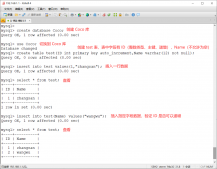MySQL 基础常用命令
注意:MySQL在centos中安装的是5.7版本的,编辑MySQL时会有个报错,需要执行:
|
1
|
set@@global.sql_mode='STRICT_TRANS_TABLES,NO_ZERO_IN_DATE,NO_ZERO_DATE,ERROR_FOR_DIVISION_BY_ZERO,NO_AUTO_CREATE_USER,NO_ENGINE_SUBSTITUTION'; |
1. SQL语句
每个命令执行结束加分号结束
- 查询所有数据库:show databases;
- 切换数据库:use 库命名;
- 创建数据库:create database [IF NOT EXISTS] 库名;
- 删除数据库:drop database [IF EXISTS] 库名;
- 查询数据库创建:show 建库语句;
- 指定数据库采用的字符集:CHARACTER SET
- 修改数据库的编码集:alter database 数据库名 CHARACTER SET 编码集;
注意:不要修改mysql服务器的编码集,表的编码集默认和库一致
2. 建表
格式:
- create table [if not exists] 表名(
- 字段1 数据类型 字段属性,
- 字段2 数据类型 字段属性,...
- 字段N 数据类型 字段属性
- )engine=引擎 default charset=编码集;
- 查看当前数据库:select database();
- 查看建表语句:show create table 表名;
- 查看表结构:desc 表名;
- 删除:drop table [if exists] 表名;
3.字段属性
- not null:没给值数据为默认值(varchar默认值为空
- AUTO_INCREMENT定义列为自增的属性,一般用于主键,数值会自动加1
- PRIMARY KEY关键字用于定义列为主键,您可以使用多列来定义主键,列间以逗号分隔
- ENGINE 设置存储引擎,CHARSET 设置编码
- default null:没给值数据就是null
- default 值:设置字段的默认值
注意:主键不重复的列
这里我们建立一个student表:
|
1
2
3
4
5
6
|
create table if not EXISTS student (id int auto_increment,`name` VARCHAR(32), age int,sex char(1),clazz VARCHAR(32)) charset utf8; |
|
1
2
3
4
5
6
7
8
|
insert into student values (1001,'zs',18,'男','一班');insert into student values (1002,'ls',19,'女','二班'); insert into student(`name`,age,sex,clazz) values ('ww',69,'男','一班'); insert into student(`name`,age,sex,clazz) values ('we',21,'女','二班');insert into student(`name`,age,sex,clazz) values ('ld ',23,'男','一班');insert into student(`name`,age,sex,clazz) values ('lq',45,'女','二班');insert into student(`name`,age,sex,clazz) values ('lwq',23,'男','一班'); insert into student(`name`,age,sex,clazz) values ('ld',12,'女','二班'); |
4.修改表:alter table
修改表名:alter(rename) table 旧表名 to 新表名;
rename table student1 TO `student`;
添加字段:alter table 表名 add 字段 字段数据类型 属性;
|
1
2
3
4
5
6
|
alter table student add job varchar(32) default '没有工作' ;insert into student (job) VALUES('a');insert into student (job) VALUES('b');insert into student (job) VALUES('c');insert into student (job) VALUES('a'); insert into student (job) VALUES('b'); |
修改字段:alter table 表名 change 旧字段 新字段 数据类型 属性;
|
1
2
|
alter table student change clazz clazz varchar(255);alter table student change age score double; |
修改字段:alter table 表名 modify 字段 数据类型 属性;
|
1
|
alter table student MODIFY varchar(356); #这里不能比之前的空间小 |
注意:
- change:修改所有(字段名,数据类型,属性)
- modify:修改一部分(数据类型,属性)
- 修改数据类型时,varchar->int元数据会变为0
5. 增删改查:字符串全部使用''包起来
5.1 增
格式:
|
1
2
3
4
5
6
7
8
9
|
insert into 表名(字段) values(值),(值)...(值); insert into student values (1001,'zs',18,'男','一班');insert into student values (1002,'ls',19,'女','二班');insert into student(`name`,age,sex,clazz) values ('ww',69,'男','一班');insert into student(`name`,age,sex,clazz) values ('we',21,'女','二班');insert into student(`name`,age,sex,clazz) values ('ld ',23,'男','一班');insert into student(`name`,age,sex,clazz) values ('lq',45,'女','二班');insert into student(`name`,age,sex,clazz) values ('lwq',23,'男','一班');10 insert into student(`name`,age,sex,clazz) values ('ld',12,'女','二班'); |
5.2 删
|
1
2
|
-- 删除delete from 表名 where 子句;delete from student where job='c'; |
5.3 改
|
1
2
|
-- 改update 表名 set 字段1=值1,字段2=值2...字段N=值N where 子句;update student set job='b'where name ='ls'; |
5.4 查
|
1
2
3
|
-- 查select 字段 from 表名 where 子句; select * from student ; #查询全部 SELECT id as di,name,job,score from student where score>18; #特定查询,并且展示特定的表 as:表示改字段名称(原来的表不发生变化) |
注意:表示所有字段
6. 子句
- > < <= >= = <> 大于、小于、大于(小于)等于、不等于
- between ...and... 显示在某一区间的值(含头含尾)
- in(set) 显示在in列表中的值,例:in(100,200)只能匹配100或200
- like '张_' 模糊查询 使用% 和 _(%表示匹配所有 _匹配一个)
- Is null 判断是否为空
- and 多个条件同时成立
- or 多个条件任一成立
- not 不成立,例:where not(expection>10000);
|
1
2
3
4
5
6
7
8
9
10
11
12
13
14
|
-- > < <= >= = != 大于、小于、大于(小于)等于、不等于SELECT * from student WHERE id>1006;SELECT * from student WHERE id!=1006; --between ...and... 显示在某一区间的值(含头含尾)select id,name,job from student where id BETWEEN 1002 and 1005; select * from student where job BETWEEN 'a' and 'b'; -- in(set) 显示在in列表中的值,例:in(100,200)只能匹配100或200 select * from student where job in('a','b');-- like '张_' 模糊查询 使用% 和 _(%表示匹配所有 _匹配一个) SELECT * from student where name like 'l%'; SELECT * from student where name like 'l_';select * from student where name is not null; |
7.limit分页
格式:
语句 limit 开始下标,长度;
|
1
2
3
4
|
-- limit分页 语句 limit 开始下标,长度;注意:没有whereselect * from student LIMIT 1,2;select * from student LIMIT 0,2;select * from student LIMIT 2; |
注意:
如果数据量不够,显示全部
8.去重
格式:
DISTINCT 字段1,字段2...字段N
|
1
2
3
|
-- 去重 DISTINCT 字段1,字段2...字段Nselect DISTINCT name from student;select count(DISTINCT name) from student; |
注意:
字段不能在DISTINCT之前,只能在DISTINCT后面
DISTINCT之后有多个字段,按照所有字段进行去重
9.聚合函数
- count(字段):求多少行数据
- sum(字段):求和
- avg(字段):平均数
- max(字段):最大值
- min(字段):最小值
注意:
- varchar能比较大小,不能获取avg(没有任何意义)
- 如果值为Null不参与计算
- sum和avg字段的数据不是数值,结果都是0
|
1
2
3
4
5
6
7
8
9
10
11
12
13
14
15
16
17
|
-- count(字段):求多少行数据select count(*) from student; select count(name) from student;-- sum(字段):求和select sum(score) from student;select sum(job) FROM student;select name+score as sum FROM student; #score的值 SELECT name*score as cheng FROM student; #0-- avg(字段):平均数 SELECT avg(score) FROM student; -- max(字段):最大值SELECT max(score) FROM student;SELECT max(job) FROM student; #c-- min(字段):最小值SELECT min(score) FROM student; |
10.拼接
格式1
concat(str1,str2...)
格式2:
concat_WS(separator,str1,str2,...)
|
1
2
3
4
|
-- 格式一:concat(str1,str2...) select CONCAT(id,'-',name) as pj FROM student; -- 格式二:concat_WS(str1,str2...)SELECT CONCAT_WS('~',id,name,score,job)FROM student; #中间以~隔开 |
11.日期函数
获取当前日期:
|
1
2
3
4
5
6
7
8
9
10
11
12
13
14
15
16
17
18
19
20
21
22
23
24
25
26
|
current_timestamp;--所有current_timestamp();--所有CURRENT_DATE();-- 年月日CURRENT_DATE;-- 年月日CURRENT_TIME();-- 时分秒CURRENT_TIME;-- 时分秒-- 获取当前日期:-- current_timestamp;--所有SELECT CURRENT_TIMESTAMP from student;-- current_timestamp();--所有 SELECT CURRENT_TIMESTAMP() from student; -- CURRENT_DATE();-- 年月日 select CURRENT_DATE() from student;-- CURRENT_DATE;-- 年月日 select CURRENT_DATE from student;-- CURRENT_TIME();-- 时分秒 SELECT CURRENT_TIME() FROM student;-- CURRENT_TIME;-- 时分秒SELECT CURRENT_TIME FROM student; |
时间转str
格式:
date_format(date,format)
date:时间
format:格式
str转日期
格式:
str_to_date(str,formaat)
|
1
2
3
4
5
6
7
8
9
10
11
|
SELECT * FROM date; -- 时间转str -- 格式: -- date_format(date,format)-- date:时间-- format:格式select DATE_FORMAT('2021-09-01','%Y~%m~%d');-- str转日期-- 格式: -- str_to_date(str,formaat) SELECT STR_TO_DATE('2021-09-01','%Y-%m-%d'); |
日期相减
格式:
datediff(expr1,expr2);
注意:只能相减年月日,时分秒参与运算结果为null
|
1
2
3
|
datediff(expr1,expr2);-- 注意:只能相减年月日,时分秒参与运算结果为nullSELECT DATEDIFF('2021-09-09','2021-09-01'); |
函数向日期添加指定的时间间隔
格式:
DATE_ADD(date,INTERVAL expr unit);
date:时间
INTERVAL:关键字
expr:间隔的数值
unit:年月日时分秒(..,...,day,..,..,..)
|
1
2
|
SELECT DATE_ADD('2021-09-09',INTERVAL +10 YEAR);SELECT DATE_ADD('2021-09-09',INTERVAL +10 DAY); |
12. 数组计算
round(x,d):四舍五入
x:值
d:保留几位小数点
ceil(x):向上取整
floor(x):向下取整
rand():随机数(0-1之间)
|
1
2
3
4
5
6
7
8
9
10
11
12
|
-- 数组计算-- round(x,d):四舍五入 -- x:值 -- d:保留几位小数点SELECT ROUND(1.3,2); #2表示保留几位小数-- ceil(x):向上取整 SELECT ceil(1.2);-- floor(x):向下取整 SELECT floor(1.2);-- rand():随机数(0-1之间) SELECT rand(); |
13.排序
格式:
order by 字段1 asc|desc,字段2 asc|desc...字段n asc|desc;
|
1
2
|
SELECT * from student ORDER BY score,job; SELECT * from student ORDER BY score desc, job desc; |
注意:
- 默认升序asc,降序desc
- 如果有多个字段,按照先后顺序依次排序
14. group by 分组
格式:
group by 字段1,字段2...字段n;
注意:
- 多个字段,按照所有字段进行分组(一起分组)
- 有多少组显示多少条数据(默认情况下,没有经过条件筛选)
- 组显示的数据为每组中默认第一条数据
- by 通常和聚合函数一起使用
|
1
2
3
4
5
6
7
8
9
10
11
12
13
14
15
16
17
18
19
20
|
select max(score) as c from student where score=c;select max(score) as c from student having score=c;两个都不能运行SELECT count(*),job,`name`,id as c from student GROUP BY sex where c>2; #错误SELECT count(*) as c,job,`name`,id from student GROUP BY sex HAVING c>2;-- select id,name,sex from student where job='a'; # 可以运行--select id,name,sex from student having job='a'; #不能运行(显示了之后就没有job)-- 执行过程是 from-where-select-having-- select count(*) c from student where c>1; -- 不行-- select count(*) c from student having c>1;-- 行select count(*) c,sex from student group by sex where sex='男';select count(*) c,sex from student group by sex having sex='男';--where having 一起使用SELECT count(*)as c,name,id FROM student where sex='男' HAVING c>3;where 是对表中from到的数据进行筛选;having是对表中selec显示数据进行晒选; |
到此这篇关于MySQL 基础常用命令总结的文章就介绍到这了,更多相关MySQL常用命令内容请搜索服务器之家以前的文章或继续浏览下面的相关文章希望大家以后多多支持服务器之家!
原文链接:https://www.cnblogs.com/lmandcc/p/15228773.html

















